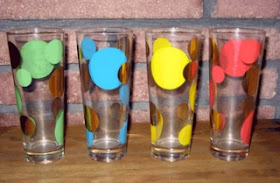According to Ann Kerr in Collector's Encyclopedia of Russel Wright, Wright's relationship with Imperial began in 1941 when they produced the seeded glass Flair. In 1949 the Flame line was added, which was later called Twist. These patterns were said to be produced in seaspray (a pale aqua), hemlock (a deep forest green), ripe olive (a deep brown), verde (a green gold) and crystal. These (first and third pictures below) were shown in an early Imperial ad in Kerr's book, along with the Pinch pattern. Kerr also included photos of a slightly different shape of Flair glassware, like the second photo below, although she didn't include an ad verifying the identification. My knowledge isn't extensive enough to confirm or refute this attribution.
 |
| Flair by Imperial (spelled "Flare" in early ads) worthpoint.com |
 |
| Another Flair shape, according to Ann Kerr modfather.com |
 |
| Twist by Imperial (originally called Flame) modfather.com |
The Pinch line by Imperial was added in 1951 to accompany Iroquois Casual. It was produced in verde, seafoam, smoke, cantaloupe, chartreuse, ruby, pink and crystal.
 |
| Pinch by Imperial modfather.com |
In 1957 Wright was commissioned to decorate the Oklahoma line of Bartlett-Collins in Sapulpa, Oklahoma. The only two designs he allowed his name to be used with in advertising were Eclipse and Asterisk, though other styles were later produced in the tapered Oklahoma shape, as well as in a straight shape. Fellow blogger wedgwoodtulsa has a nice post about Eclipse glassware, as well as the best photos I found of all four colors. In 1958 they were called blue, flamingo, yellow and green, and all had gold moons. In 1960 the color names were changed to blue, tangerine, yellow and green, although flamingo and tangerine were likely the same color.
 |
| Eclipse by Bartlett-Collins, sometimes called Sooner glasses wedgwoodtulsa.blogspot.com |
 |
| Asterisk by Bartlett-Collins modfather.com |
In 1963 Wright contracted with Yamato in Japan to produce the Theme Formal line, which included these opaline white glasses. Advance sales were not successful, and there are indications that only samples were produced.
 |
| Theme Formal by Yamato modfather.com |
I hope this information is beneficial to those of you who are new to Russel Wright glassware and helps you get some great bargains when you're hitting estate sales, thrift stores or eBay.















































